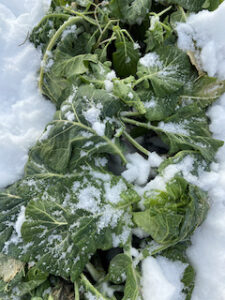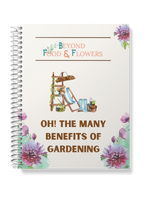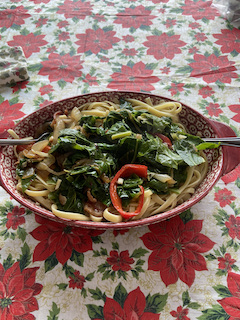Still In The Garden

Collards
These are my collard greens. It’s December 11, 2020 and I’m out in the garden, wearing my safety orange, of course, and my boots and mittens. Collards and kale are both members of the brassica family of vegetables. Think cabbage family. They were commonly grown in Colonial America but were used more for animal feed than human food at that time. When they were cooked up in the kitchen the greens were referred to as pottages. They were usually thrown into the pot of stew or soup, hence the name. Collards hold up well with long cooking times like soups so they have an advantage over their more tender counterparts.
Collards are usually considered a Southern crop and grown in the cool seasons of the southern US. Their liking for cool temps makes them a great crop to grow here in central Maine. Collards sweeten and become more mild with frost and snow. They are best planted directly into the soil in July or even August.
Today I kicked off the snow and ice and picked the frozen leaves. Inside the house they warmed up and did just fine. I just had to rinse them and strip the leaves off the stems. They never even made it into the refrigerator!
This is the basic recipe I used. I used white onion instead of red and I served them on fettuccine noodles. I also had some sliced Carmen sweet Italian peppers in the freezer and I threw them in for color. It’s pretty cold picking greens in the snow so I didn’t stay out there long but I still ended up with about twice as many greens as I needed for the recipe so the other half went into the freezer before any seasonings were added. https://cooking.nytimes.com/recipes/12465-pasta-with-collard-greens-and-onions This is absolutely delicious and if your nervous about trying a new dark green leafy vegetable it’s a great recipe to start with.

TAKE BACK YOUR VITALITY!
Learn more about the health benefits of gardening and get some good tips and instruction too.

Kale
And the Dwarf Scottish curly kale is still very edible under the snow and ice. I have three varieties of kale in the garden and they are all holding up. I will need to pick the Red Russian Kale soon. The Scottish curly gets the prize for hardiness. I also grew a variety called Redbor. It is a very deep almost purple red color. The redness turns to the deepest emerald when it’s cooked and it makes a beautiful addition to a salad or cooked dish. I had to harvest mine early because the rouge hen likes to escape her yard just to eat this kale. You can find Redbor seed here: https://www.johnnyseeds.com/vegetables/kale/redbor-f1-kale-seed-2184.html
If you are new to kale, I suggest removing the leafy part from the stem. I like kale a lot but I don’t eat the stems. with both Collards and kale I give the stems and unwanted leaves to the chickens. Getting greens and left over squash in the winter keeps the egg yolks nice and bright. Kale can be sautéed up with onion and garlic and served with just about anything. I often add greens to my smoothies. kale is a stronger tasting green than spinach so use very young leaves (or snow kissed ones) and use them in small amounts for smoothies.

